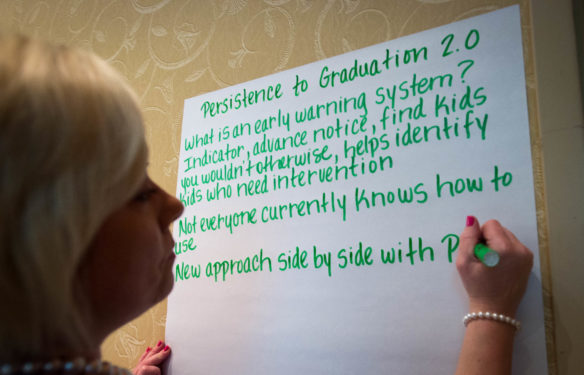
Cynthia Miracle, a guidance counselor in the Anderson County schools, asks questions of Michael Mock of Infinite Campus after a presentation on the Early Warning Tool. The tool, an updated version of the Persistence to Graduation Tool, debuted at the inaugural Persistence to Graduation Summit in Lexington.
Photo by Bobby Ellis, June 6, 2016
By Mike Marsee
michael.marsee@education.ky.gov
A tool that schools are using to keep students on track for graduation has gotten a little sharper.
The Kentucky Department of Education is rolling out an enhanced Persistence to Graduation Tool (PtGT) to identify students who may be off track for promotion or on-time graduation.
The new Early Warning Tool is being released to school districts this month through Infinite Campus, the Minnesota-based firm that manages it, but educators were able to get a preview of the new tool a few weeks early at KDE’s inaugural Persistence to Graduation Summit.
“The goal is to identify all future dropouts,” Barry Brahier, a product champion with Infinite Campus, told a group of educators at the summit in Lexington.
That means making better predictions about students who are likely to leave school early, and that will be done with a system that learns from its historical track record and makes use of data mining, the process of analyzing databases to discover patterns.
Christina Weeter, the director of KDE’s Division of Student Success, said data mining is one of the most important features of the new tool.

Donna Deal of the Kentucky Department of Education writes down highlights from a presentation about the Early Warning Tool at the Persistence to Graduation Summit.
Photo by Bobby Ellis, June 6, 2016
“The Early Warning Tool looks at the three main indicators that a student may drop out: attendance, behavior and course performance. It also has a number of enhancements and the data-mining capability,” Weeter said.
Brahier said the Early Warning Tool incorporates all of the features of the previous Persistence to Graduation Tool, but the original tool only draws upon data that individual schools and districts can see.
“It does break entirely new ground, because it allows districts to automatically use all this data they’re acquiring, but also to work with a huge amount of statewide data,” he said. “Instead of just the data in the school or for one child, what we have is all the data for all the years across the Commonwealth of Kentucky.”
Brahier said the broader database will allow for more accurate predictions of whether a student will drop out. He said the advantages of the Early Warning Tool over the original Persistence to Graduation Tool are that the new system:
- maximizes predictive accuracy.
- learns from more data to identify more risk factors.
- improves over time.
KDE launched the Persistence to Graduation Tool in 2011 to support schools in meeting the graduation and college- and career-readiness goals mandated by Senate Bill 1 (2009) and the Commonwealth Commitment to College and Career Readiness.
The new Early Warning Tool initially will be available only to grades 9-12, though it will eventually be expanded for use with all grade levels.
“The original Persistence to Graduation Tool will still be available as a resource for younger grades, but it will eventually be phased out as the functionality of the new tool is expanded for use with all grades,” Weeter said. “The new Early Warning Tool is intended to be used at all levels, even in elementary school.”
Representatives of Infinite Campus were on hand at the Persistence to Graduation Summit to show what the Early Warning Tool can do. For example, educators engaged in dropout prevention and re-engagement will be able to view a score that indicates a student’s risk of dropping out and a detailed early-warning dashboard for each student.
“The Early Warning Tool summarizes a student’s risk factors for dropping out of school in relation to the other students in the same school,” Brahier said. “It comes down to making predictions.”
Daniel Jarratt, a data scientist with Infinite Campus, said developers worked to ensure that those predictions are more accurate than ones made by the previous version.
“For every correct answer, for every student you correctly predict is going to drop out, how many false alarms is it going to raise?” he said. “Every place on the continuum, we have fewer false alarms than the previous tool, and we are the best when we look at kids in the riskiest situations. We built the tool to be the best in that situation, because those are the kids for whom we want to intervene.”
Brahier said their work won’t end with the August launch.
“We’re going to continuously improve it, so it’s just going to keep getting better and better,” he said.
Weeter said KDE will offer training on the new tool this fall.
Both the Early Warning Tool and the Persistence to Graduation Summit are part of KDE’s Persistence to Graduation initiative, which provides support to schools and districts to identify students who may be off track for promotion, graduation or college and career readiness.
In its first year, the summit attracted more than 450 teachers, school counselors, principals, Family Resource and Youth Service Center staff members, social workers, directors of pupil personnel, superintendents and community members interested in dropout prevention and reengagement.
Presenters focused on successful strategies for dropout reduction and prevention, and student reengagement. Peer-driven sessions allowed time for an exchange of ideas rather than simply a lecture or a presentation.
KDE’s Alternative Learning Branch launched the summit to provide further support to schools, districts and community partners in successfully engaging students in school until they earn a high school diploma. Weeter said KDE saw a need for more support after the compulsory education age was raised from 16 to 18 years old with the passage of Senate Bill 97 (2013).
“We recognized that we can’t just put a policy in place and not provide support. The summit is an effort to provide training and support to districts,” Weeter said. “We hope this will be a yearly event.”
MORE INFO …
Persistence to Graduation Tool information from KDE
Christina Weeter christina.weeter@education.ky.gov









Leave A Comment